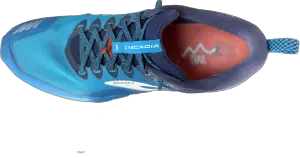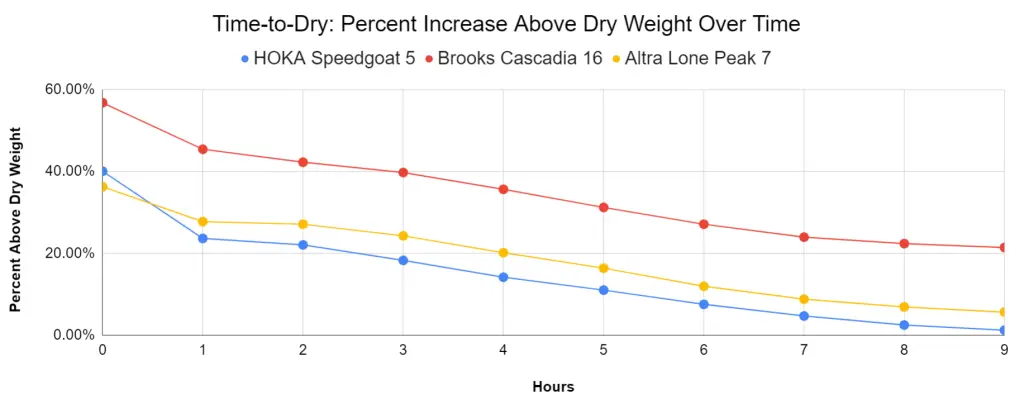I tested the Brooks Cascadia 16 over 40 miles of hiking, including portions of an 85-mile thru-hike from Bologna to Florence, Italy. They are the best trail running shoes I have ever tested for hiking.

Not convinced?
Read on to find out why they are so good.
The Brooks Cascadia 16 are excellent trail running shoes for hiking. They exhibit excellent traction, protection, stability, and comfort performance compared to other trail running shoes like the Altra Lone Peak 7 and the HOKA Speedgoat 5. In testing for time-to-dry, they performed worse than the Altras and the HOKAs, but they do have ports to get rid of water.
I tested these shoes against two other popular trail running shoes for hiking. Check out my comparison review here.
The Brooks Cascadia 16 are exceptional because they are not exceptional at anything.
Yes, read that again.
The Brooks Cascadia 16 do everything well because they do not try to excel at anything. I tested them for Comfort, Protection, Traction, and Stability.
Other shoes inevitably give more importance to one of these factors to the detriment of one of the others. The Cascadia 16 is above average at everything. Check out the current models and pricing.

Comfort
When you hike 15 to 20 miles per day, and you swap out your shoes every 5 to 6 miles for five days, you know which shoe you want to hike in.
On day two, I knew the Brooks Cascadia 16 was my preferred shoe over the other two.
They feature the new DNA LOFT v2 that Brooks claims is softer than the Cascadia 15.
I found them to be very cushioning. I wore the HOKA Speedgoat 5 on the same days during the hike, and I could not detect any significant difference in cushioning on the trail between the shoes, and the HOKA are famous for their soft ride.
They excel in comfort, in my experience.
I did not develop hot spots, blisters, or any other problems on my skin while wearing the Brooks Cascadia 16, even on the long legs of the five-day trek. The last provides a nice balance between a snug fit and a forgiving fit that will work for many different foot types. The toe area is generous enough but not sloppy.

Stability
The Brooks Cascadia 16 excels in Stability. When comparing them to the HOKA Speedgoat 5 and the Altra Lone Peak 7, the difference was stark.
They provide a more stable ride for hiking on various terrains. I walked on grass, asphalt, mud, rocks, an ancient Roman road, gravel, and dirt.
One feature I like about the Brooks Cascadia 16 is the flexible protection plate. They call it the Ballistic Rock Shield.
Other shoes that feature rock plates sometimes leave you teetering on larger stones on trail. The Brooks Cascadia 16 provides more stability while also providing excellent protection.
On day five of my five-day trek, rain poured in the morning. I ascended 600 meters on mud paths in the woods. On the Strava app, I was ranked number 10 overall for this leg of this path. That is a testament to how well these shoes work in less-than-ideal trail conditions.

Protection
As stated above, the Ballistic Rock Shield is a great feature on these shoes that both provide underfoot protection and do not introduce instability. The uppers are also quite protective, with substantial materials and a toe cap.
I did head-to-head testing for protection underfoot, pitting the Brooks Cascadia 16 against the Altra Lone Peak 7 and the HOKA Speedgoat 5.
To conduct the testing, place a different shoe on each foot and then step on a small stone to see how much the shoes transfer to the bottom of my foot. The shoe that transmits less of the shape of the stone wins.
The Cascadia 16 and the Speedgoat 5 tied for first place. When stepping on the stone, I could not detect a significant difference between the two. The Altra Lone Peak 7 is a more minimalist shoe with less stack height and, therefore, lost to both the Brooks and HOKA.
Over the five-day hike, I did stub my toe occasionally with all three shoes and had zero issues.
I would also step on sharper rocks on gravel portions of the trail, and again I had zero issues with damage to my feet while hiking in the Brooks Cascadia 16.
Time-to-Dry
The Brooks Cascadia 16 features drain ports for removing excess water inside the shoe.
The version I have is not water-resistant.
I hiked in a rain storm in these shoes and found that they got rid of any water inside the shoe but soaked up a significant amount of water.
I also tested these shoes for time-to-dry against the HOKA Speedgoat 5 and the Altra Lone Peak 7. In this testing, I record their dry weight, dunk them in water, and then reweigh them to see how much water weight they have gained. I set them out to dry and reweigh them every hour until one shoe returns close to its dry weight.

You can see on the graph that the Brooks Cascadia 16 took significantly more water than the other two shoes. Consequently, after 9 hours, it still carried 20% above its dry weight in water.
The Brooks Cascadia 16 is a more substantial shoe than the HOKA or Altra, with more padding and materials. This fact is reflected in how it performed in this test.
Final Thoughts
The Brooks Cascadia 16 are excellent trail runners that work well for hiking. I hiked 40 miles in them, including 27 miles or so on an 85-mile thru-hike.
I was very impressed with them. They provide reliably outstanding performance for comfort, protection, traction, and stability. They did not perform as well as the other shoes tested for time-to-dry.
The Brooks Cascadia 17 has already been released, and I look forward to getting a pair of those soon.
